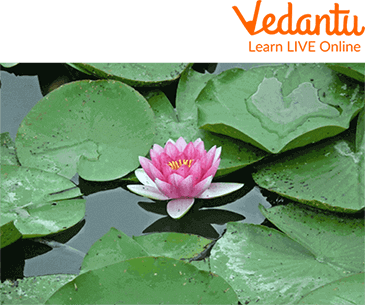




Overview of Water Lily
Have you ever seen plants in water? Plants that grow in still water or slow-moving water are known as water lilies. They are flowering plants. There are about 60 species of water lilies in the world. They grow in ponds, on the edges of lakes, and in water streams. They also grow in tropical and mild areas. The floating leaves of water lilies are called lily pads. Frogs love to sit on lily pads. They jump from one lily pad to another.
In this article, we will learn about water lilies, what lily pads are, and facts about water lily. So, let us start learning about water lilies.

Water lily
Introduction to Water Lily
Water lily belongs to the family Nymphaeaceae. They produce flowers and seeds, hence are considered flowering plants. They are also accepted as land plants as they are rooted in soil in bodies of water. Although leaves and flowers float on the surface of the water. It is also considered the jewels of the ponds. They are beautiful-looking plants. They play an important role in the ecosystem as creatures sit and live on water lilies safely. They are so pleasing to the eyes.
They keep the hot temperature of the water down during the summer season by providing shade to the water and creatures living in it. They stop the growth of algae in water by stopping the excess sunlight from falling. They absorb nutrients from the water. They provide shelter to the small fishes. Flowers of water lilies open in the daytime and close in the evening. If water lilies get an appropriate environment they will grow for 15-20 years.

Yellow Water Lily
What are Lily Pads?
The leaves of the water lily grow to 6 feet. Commonly the leaves float on the surface but sometimes they can be underwater also. Lily pads are the floating leaves of water lilies. They are so attractive. They are the most seen part of the plant. The shape of the water lily varies. They can be rounded, heart, or shield-shaped. They are broad in appearance.
The work of lily pads is to bring more and more light to the plant for photosynthesis. The lily pads are adaptations for water lilies to survive in the water. Water lilies are of different colours, like pink, white, yellow, and red. Lily pads survive for 3-4 weeks. After that, they die and sink into the pond. Herbicides are harmful to water lily pads. They can kill them.

Water Lily Pads
Adaptation in Water Lily
Adaption is the property that supports an organism to survive in any environment. Water lilies have some adaptations that will help them to live. The long leaf stalks filled with air spaces are present on the leaves of the water lily. It helps the plant to float on water. An oily coat is present on the leaves of the water lily. The leaf blades are broad. Only the air-exposed areas of leaves have stomata on them. Water lilies get more sunlight for the process of photosynthesis with the help of lily pads.
Facts About Water Lily
Some interesting facts about water lily are as follows:
There are many varieties of colours in water lily plants.
Water lilies support their surroundings.
The water lily is known as July’s birth flower.
The water lily is considered a spiritual symbol.
In the art world, a water lily is a star.
They are native to the temperature.
They are present in Asia, America, Europe, Africa, and Australia.
They are fragrant solitary flowers.
Differences Between Lotus and Water Lily
Following is the difference between lotus and water lily.
Summary
In this article, we have discussed facts about water lilies, water lily adaptations, and the difference between lotus and water lilies. The water lily is from the family Nymphaeaceae. They are colourful, attractive flowering plants. They are accepted as water plants as well as land plants because they grow and survive on both water and land. They provide habitat to many organisms in the pond.
The leaves of water lilies can grow to 6 feet. Lily pads (the floating leaves) are present in them. Water lilies can be alive for 15-20 years if they get a favourable conditions. It produces a fruit that looks like nuts are present inside them. Fishes, ducks, and other animals eat them. Water lilies can also be grown in garden ponds.
FAQs on Facts About Water Lily
1. Is water lily poisonous?
Yes, water lilies are poisonous. Approximately all water lilies are poisonous. Seeds can be non-poisonous, rest all other parts are poisonous.
2. Is water lily considered lucky?
People believe that a water lily is a lucky flower. It is considered a symbol of positivity and happiness.
3. Which Lily smells the best?
Oriental lilies smell the best. All lilies are fragrant and have a good smell.









